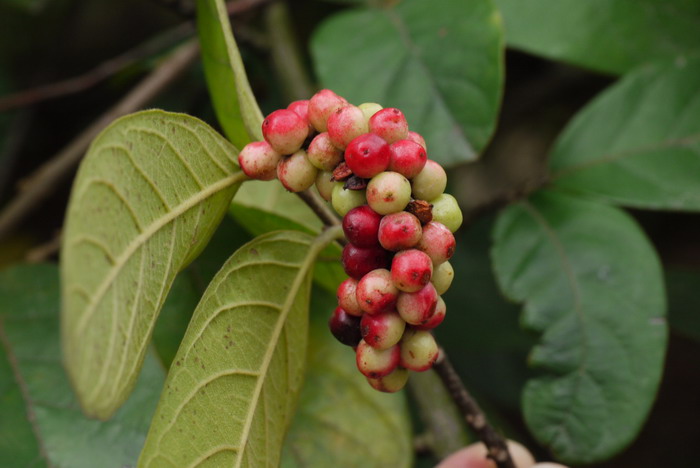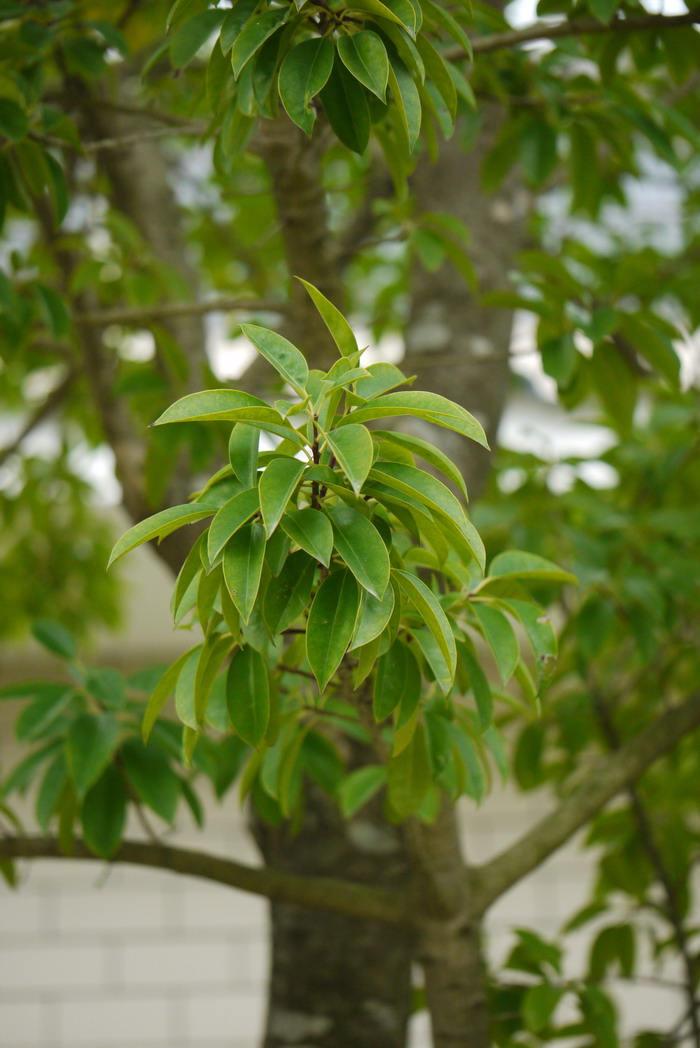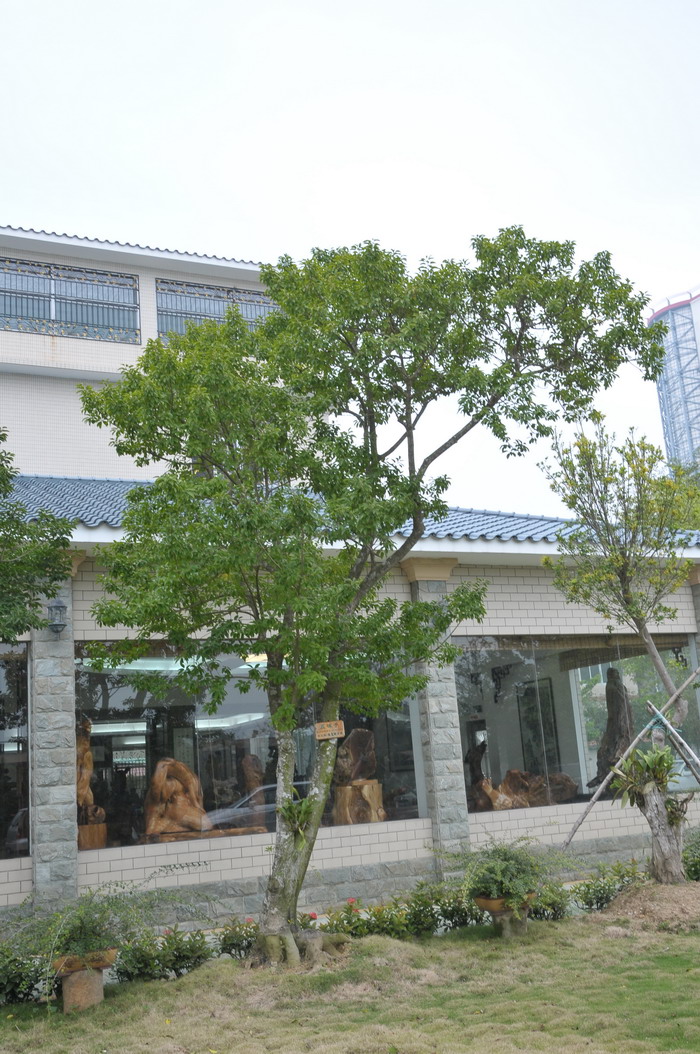五月茶Antidesma bunius
中文名(Chinese Name):五月茶
学名(Scientific Name):Antidesma bunius (L.) Spreng.
英文名(English Common Name):bignay
别名(Chinese Common Name):污槽树
异名(Synonym):Antidesma thorelianum Gagnep. Antidesma dallachyanum Baill. Antidesma collettii Craib Stilago bunius L. Antidesma andamanicum Hook.f. Antidesma floribundum Tul. Antidesma ciliatum C.Presl Antidesma crassifolium (Elmer) Merr. Antidesma glabellum K.D.Koenig ex Benn. Antidesma glabrum Tul. Antidesma stilago Poir. Antidesma rumphii Tul. Antidesma retusum Zipp. ex Span. Antidesma cordifolium C.Presl Sapium crassifolium Elmer Antidesma bunius var. sylvestre (Lam.) Müll.Arg. Antidesma bunius var. wallichii Müll.Arg. Antidesma bunius var. floribundum (Tul.) Müll.Arg. Antidesma bunius var. genuinum Müll.Arg. Antidesma bunius var. cordifolium (C.Presl) Müll.Arg.
科属(Family & Genus):大戟科(Euphorbiaceae)五月茶属
形态特征(Description):乔木,高达10米;小枝有明显皮孔;除叶背中脉、叶柄、花萼两面和退化雌蕊被短柔毛或柔毛外,其余均无毛。叶片纸质,长椭圆形、倒卵形或长倒卵形,长8-23厘米,宽3-10厘米,顶端急尖至圆,有短尖头,基部宽楔形或楔形,叶面深绿色,常有光泽,叶背绿色;侧脉每边7-11条,在叶面扁平,干后凸起,在叶背稍凸起;叶柄长3-10毫米;托叶线形,早落。雄花序为顶生的穗状花序,长6-17厘米;雄花:花萼杯状,顶端3-4分裂,裂片卵状三角形;雄蕊3-4,长2.5毫米,着生于花盘内面;花盘杯状,全缘或不规则分裂;退化雌蕊棒状;雌花序为顶生的总状花序,长5-18厘米,雌花:花萼和花盘与雄花的相同;雌蕊稍长于萼片,子房宽卵圆形,花柱顶生,柱头短而宽,顶端微凹缺。核果近球形或椭圆形,长8-10毫米,直径8毫米,成熟时红色;果梗长约4毫米。染色体基数x=13。花期3-5月,果期6-11月。
分布(Distribution):产江西、福建、湖南、广东、海南、广西、贵州、云南和西藏等省区,生于海拔200-1500米山地疏林中。广布亚洲热带地区直至澳大利亚昆士兰。
用途(Use):散孔材,木材淡棕红色,纹理直至斜,结构细,材质软,适于作箱板用料。果微酸,供食用及制果酱。叶供药用,治小儿头疮;根叶可治跌打损伤。叶深绿,红果累累,为美丽的观赏树。
引自中国植物志英文版FOC Vol. 11 Page 209, 210, 211
Antidesma bunius (Linnaeus) Sprengel, Syst. Veg. 1: 826. 1824.
五月茶 wu yue cha| Euphorbiaceae | Antidesma
Trees, rarely shrubs, up to 30 m tall; young twigs glabrous to very shortly pubescent. Stipules linear, 4-6 × 1.5-2 mm, caducous; petiole 3-10(-17) mm, glabrous to pubescent; leaf blade oblong, elliptic, or obovate, (5-)10-23(-32) × (2-)3-10 cm, leathery or thickly papery, glabrous except sometimes midvein pilose, or abaxially reddish pubescent, shiny, usually drying dark green (sometimes grayish or reddish) adaxially, slightly lighter abaxially, base acute to rounded, apex acute to rounded, sometimes slightly emarginate or acuminate, usually mucronate; domatia absent; midvein flat to impressed adaxially, lateral veins (5-)7-11 pairs, tertiary veins reticulate. Inflorescences axillary or terminal, axes glabrous to pubescent, robust, males 6-17(-25) cm, 3-8(-14)-branched, females and fruiting (4-)10-18 cm, unbranched or more rarely up to 4-branched. Male flowers sessile; calyx 1-1.5 mm, cup-shaped, 3- or 4(or 5)-lobed, divided for 1/4-1/3, glabrous to pubescent outside, reddish long pubescent at base inside, margin fimbriate, apex of lobes obtuse to rounded; disk annular, consisting of free lobes or enclosing stamens and pistillode, glabrous; stamens 3 or 4(or 5), 2-3 mm; rudimentary ovary clavate to cylindric. Female flowers: pedicels 0.5-1(-2) mm, 2-4(-9) mm in fruit; calyx 3-lobed, otherwise as in male; disk glabrous; ovary glabrous or pilose; stigmas 3 or 4(-6). Drupes ellipsoid, laterally compressed, 5-11(-?18) × 4-7 mm, glabrous or pilose, red to black when ripe; style (sub)terminal. Fl. Mar-May, fr. Jun-Nov. x = 13.
Forests; 200-1800 m. Fujian, Guangdong, Guangxi, Guizhou, Hainan, Jiangxi, Yunnan, Xizang [India (including Andaman and Nicobar Islands), Indonesia, Laos, Myanmar, Nepal, Papua New Guinea, Philippines, Singapore, Sri Lanka, Thailand, Vietnam; NE Australia (including Christmas Island), Pacific islands (Hawaii, Tahiti)].
Antidesma bunius var. bunius is widely cultivated as a fruit tree, especially in Java and the Philippines. The fruits are used in syrups, jams, and jellies; made into wine, liqueur, or brandy; and used in sauces eaten with fish. The leaves are eaten as a vegetable, and the leaves and roots are used as medicine for traumatic injury.
The species is absent in Peninsular Malaysia and nearly absent from Borneo.



(责任编辑:徐晔春)
学名(Scientific Name):Antidesma bunius (L.) Spreng.
英文名(English Common Name):bignay
别名(Chinese Common Name):污槽树
异名(Synonym):Antidesma thorelianum Gagnep. Antidesma dallachyanum Baill. Antidesma collettii Craib Stilago bunius L. Antidesma andamanicum Hook.f. Antidesma floribundum Tul. Antidesma ciliatum C.Presl Antidesma crassifolium (Elmer) Merr. Antidesma glabellum K.D.Koenig ex Benn. Antidesma glabrum Tul. Antidesma stilago Poir. Antidesma rumphii Tul. Antidesma retusum Zipp. ex Span. Antidesma cordifolium C.Presl Sapium crassifolium Elmer Antidesma bunius var. sylvestre (Lam.) Müll.Arg. Antidesma bunius var. wallichii Müll.Arg. Antidesma bunius var. floribundum (Tul.) Müll.Arg. Antidesma bunius var. genuinum Müll.Arg. Antidesma bunius var. cordifolium (C.Presl) Müll.Arg.
科属(Family & Genus):大戟科(Euphorbiaceae)五月茶属
形态特征(Description):乔木,高达10米;小枝有明显皮孔;除叶背中脉、叶柄、花萼两面和退化雌蕊被短柔毛或柔毛外,其余均无毛。叶片纸质,长椭圆形、倒卵形或长倒卵形,长8-23厘米,宽3-10厘米,顶端急尖至圆,有短尖头,基部宽楔形或楔形,叶面深绿色,常有光泽,叶背绿色;侧脉每边7-11条,在叶面扁平,干后凸起,在叶背稍凸起;叶柄长3-10毫米;托叶线形,早落。雄花序为顶生的穗状花序,长6-17厘米;雄花:花萼杯状,顶端3-4分裂,裂片卵状三角形;雄蕊3-4,长2.5毫米,着生于花盘内面;花盘杯状,全缘或不规则分裂;退化雌蕊棒状;雌花序为顶生的总状花序,长5-18厘米,雌花:花萼和花盘与雄花的相同;雌蕊稍长于萼片,子房宽卵圆形,花柱顶生,柱头短而宽,顶端微凹缺。核果近球形或椭圆形,长8-10毫米,直径8毫米,成熟时红色;果梗长约4毫米。染色体基数x=13。花期3-5月,果期6-11月。
分布(Distribution):产江西、福建、湖南、广东、海南、广西、贵州、云南和西藏等省区,生于海拔200-1500米山地疏林中。广布亚洲热带地区直至澳大利亚昆士兰。
用途(Use):散孔材,木材淡棕红色,纹理直至斜,结构细,材质软,适于作箱板用料。果微酸,供食用及制果酱。叶供药用,治小儿头疮;根叶可治跌打损伤。叶深绿,红果累累,为美丽的观赏树。
引自中国植物志英文版FOC Vol. 11 Page 209, 210, 211
Antidesma bunius (Linnaeus) Sprengel, Syst. Veg. 1: 826. 1824.
五月茶 wu yue cha| Euphorbiaceae | Antidesma
Trees, rarely shrubs, up to 30 m tall; young twigs glabrous to very shortly pubescent. Stipules linear, 4-6 × 1.5-2 mm, caducous; petiole 3-10(-17) mm, glabrous to pubescent; leaf blade oblong, elliptic, or obovate, (5-)10-23(-32) × (2-)3-10 cm, leathery or thickly papery, glabrous except sometimes midvein pilose, or abaxially reddish pubescent, shiny, usually drying dark green (sometimes grayish or reddish) adaxially, slightly lighter abaxially, base acute to rounded, apex acute to rounded, sometimes slightly emarginate or acuminate, usually mucronate; domatia absent; midvein flat to impressed adaxially, lateral veins (5-)7-11 pairs, tertiary veins reticulate. Inflorescences axillary or terminal, axes glabrous to pubescent, robust, males 6-17(-25) cm, 3-8(-14)-branched, females and fruiting (4-)10-18 cm, unbranched or more rarely up to 4-branched. Male flowers sessile; calyx 1-1.5 mm, cup-shaped, 3- or 4(or 5)-lobed, divided for 1/4-1/3, glabrous to pubescent outside, reddish long pubescent at base inside, margin fimbriate, apex of lobes obtuse to rounded; disk annular, consisting of free lobes or enclosing stamens and pistillode, glabrous; stamens 3 or 4(or 5), 2-3 mm; rudimentary ovary clavate to cylindric. Female flowers: pedicels 0.5-1(-2) mm, 2-4(-9) mm in fruit; calyx 3-lobed, otherwise as in male; disk glabrous; ovary glabrous or pilose; stigmas 3 or 4(-6). Drupes ellipsoid, laterally compressed, 5-11(-?18) × 4-7 mm, glabrous or pilose, red to black when ripe; style (sub)terminal. Fl. Mar-May, fr. Jun-Nov. x = 13.
Forests; 200-1800 m. Fujian, Guangdong, Guangxi, Guizhou, Hainan, Jiangxi, Yunnan, Xizang [India (including Andaman and Nicobar Islands), Indonesia, Laos, Myanmar, Nepal, Papua New Guinea, Philippines, Singapore, Sri Lanka, Thailand, Vietnam; NE Australia (including Christmas Island), Pacific islands (Hawaii, Tahiti)].
Antidesma bunius var. bunius is widely cultivated as a fruit tree, especially in Java and the Philippines. The fruits are used in syrups, jams, and jellies; made into wine, liqueur, or brandy; and used in sauces eaten with fish. The leaves are eaten as a vegetable, and the leaves and roots are used as medicine for traumatic injury.
The species is absent in Peninsular Malaysia and nearly absent from Borneo.
(责任编辑:徐晔春)
踩一下[1]

顶一下[2]